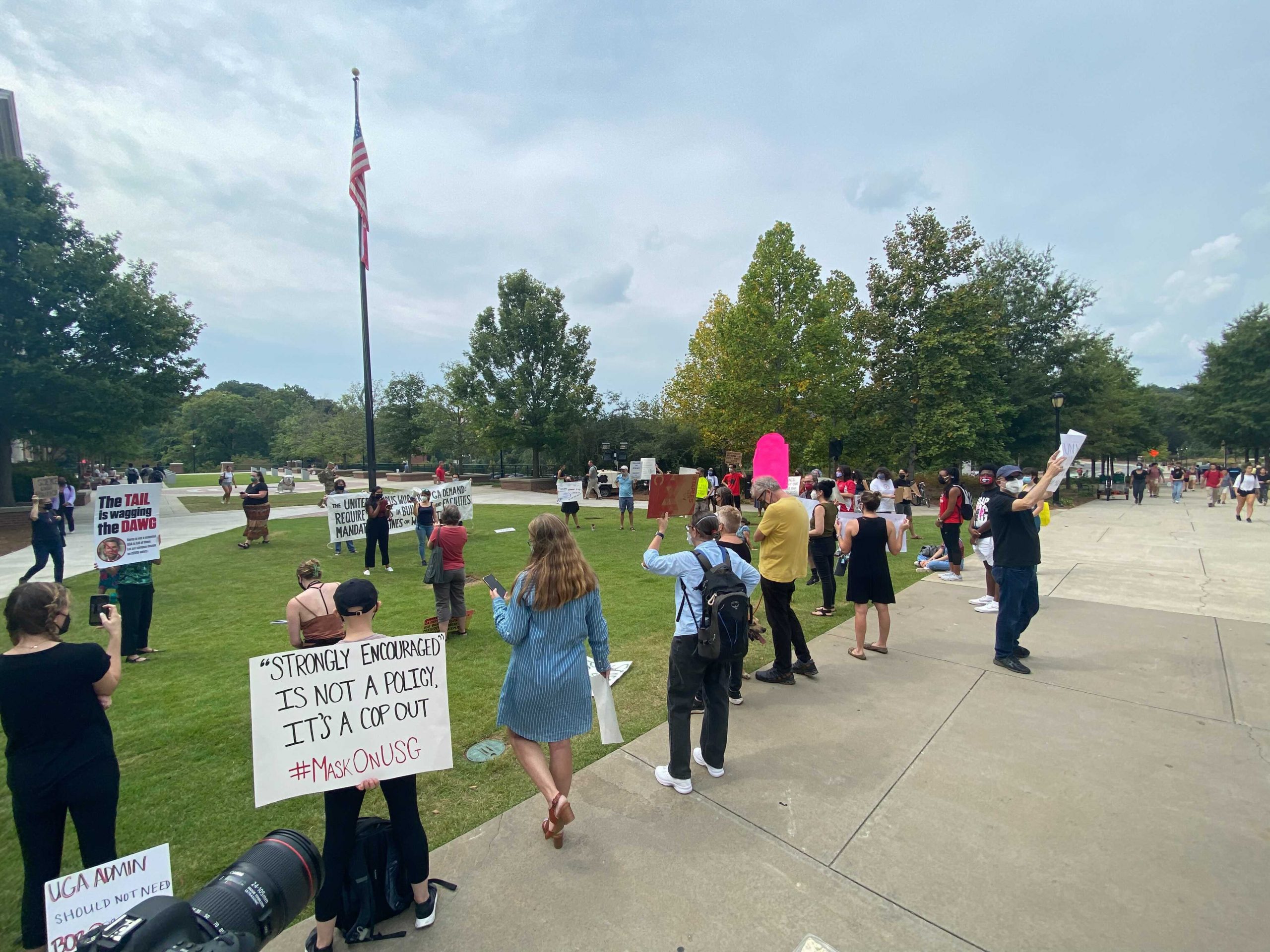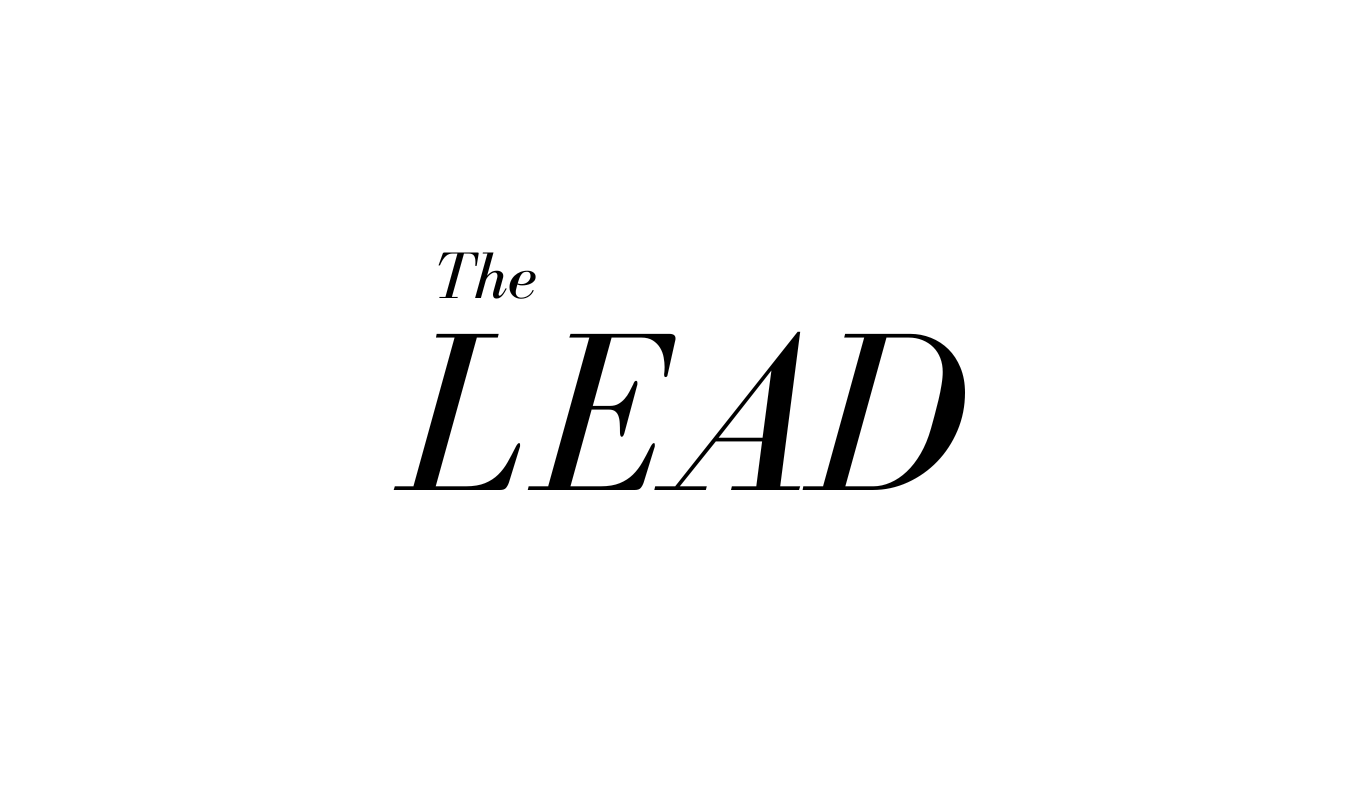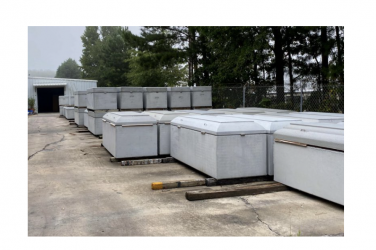Listen to the audio reporter annotation below to learn about the process that Grady Newsource reporter Shaelyn Carroll and digital producer Ballard Ackaway used to report on the demonstrations for and against mask and vaccine mandates on the UGA campus on the week of Sept. 13. They discuss the process of covering the protests, writing news for Twitter and how the story was picked up by national news outlets.
Transcript
Hi, I’m Alex Anteau, a journalism graduate assistant at Grady College.
Sept. 13 marked the beginning of a string of protests for and against mask mandates at the University of Georgia. Grady Newsource reporter Shaelyn Carroll and Digital producer Ballard Ackaway are with me today to discuss the process of covering the protests, documenting them on Twitter, and how the story was picked up by CNN.
Can y’all tell me about the roles you had documenting the story?
Ballard Ackaway: I was the digital producer for the day.
Shaelyn Carroll: And I was just supposed to be a news-gatherer for the day, but I ended up getting tossed this story.
Why did you choose to cover the protests?
SC: Our producer for the day called me at our editorial meeting in the morning and asked if I’d be willing to cover this story. We heard these protests were happening and decided that since they involved UGA and the surrounding communities, and it was kind of a statewide issue, as well, with protests happening on 16 USG campuses, that this was probably going to be our lead story for the day. Since I wasn’t working on anything else, that’s how it went down.
BA: Yeah, it was just something that we had on the schedule already. We’d looked at the Wednesday before, so it was just something that we kind of knew was going on. And obviously with rising cases of COVID in the county and the school, this is definitely something we were looking at. Our analytics kind of told us that COVID stories were playing the best with people and that’s what people were looking at the most, so this was definitely something we had on our radar.
Why did you choose Twitter as the platform to publish this story?
BA: So I chose Twitter because I figured that most of the student population would be on Twitter, so that’d also be the easiest way to reach them. I know Dr. Janet Frick is heavily involved with this story. She was at the protests and advertised them the week prior, so I figured coupling her Twitter account and her presence on Twitter with ours and the protest would be the best way to get the most out of the post and reach the most people. A Twitter thread would kind of be a one stop shop for people to look through all the videos and see what’s happening.
We knew it was gonna be a story, but I didn’t think it was going to turn into that big of a national story.”
Can you tell me more about the process of writing for Twitter?
BA: Well, I have to give a lot of credit to Shaelyn ‘cause she did send me her script. I did a lot based off of her script, so most of the content in the Twitter captions came from her. But it was a lot of editing, and a lot of, kind of, almost dumbing it down, maybe. Making it quicker to read, catch the eye easier. Also the people involved in the story, you had to find the tags for them and find the Twitter handles that have them engage with the tweet, as well. So it was a lot of taking the core of what Shaelyn wrote and putting that on to Twitter to make it catch the eye of people quicker, so they could read through it quicker and then move on to each different Tweet in the thread.
SC: I was out there reporting, and I was running around and trying to finish a package for the show at 5 that night, so I was sending Ballard just a ton of information. All my scripts, just all these big videos that he went through and simmered down. He was the one that really repackaged them and made them what they are on Twitter now.
From covering the protest to posting the videos online, how long did it take to cover the story?
BA: Well, I’d say we start out with how long it took to gather.
SC: Yeah, so I went out and the protests started at 10 that morning. The main pro-mandate protest ended within 40 minutes to an hour, and then the counter protest lasted a bit longer. So I was out there gathering information and getting interviews from around 10 to 11 or 11:30 I think. And then I came back and started working on the package, and I sent Ballard all the information.
BA: Yeah, I think I was in contact with Shaelyn and Alyssa McDaniel, who was working on the story, as well. I think it was around 11, maybe. It was right after the editorial meeting. Shaelyn sent me her b-roll as soon as she got it, and I was in contact with Dr. Bright the whole time. Amanda Bright. She was kind of helping me, walking me through how to reword her scripts, and what videos to put. Kind of helping me out, developing the thread.
I think the thread got out around 2:30. I forget the time exactly. So it took a little while. It took a good bit to take everything and consolidate it. To figure out what are the most important parts that we wanted to translate to people and which videos looked the best. Shaelyn did a really good job. She really helped me out a lot by picking out videos that had the best previews. I think that was a big thing, as well and kind of gave an overall view of what was happening. So, I think the whole process probably took about three to four hours to really get everything together.
What was your process for selecting footage?
BA: For the Twitter thread, I wanted to get a shot of the people that were seemingly running the protest to kind of lead off the twitter thread. For the second tweet, I wanted to get one of the whole crowd, just to kind of show the general amount of people that were there. For the next two, for the counter protest, I just picked out two of the best videos I saw that had the best previews, that showed the signs clearly. All those videos kind of had the whole crowd in there, because it was about ⅓ of the size of the actual mask mandate protest. I wanted to see if I could get some people talking, as well, and the natural sound in the background. I was really just kind of trying to paint a picture of the videos that Shaelyn sent me.
SC: And the videos I sent him, I just looked through the previews of the videos. I don’t think I even opened the videos. I just tried to get a variety of shots, just so that he had the option out of what I was sending him, to paint the whole picture to pretty much get everything covered.
BA: She pretty much did everything here.
SC: I think you did everything.
BA: I just kind of took whatever she sent me and put it up there. I could not have done it without her in this.
Can you describe the experience of covering protests in the field?
SC: Yeah, it was really interesting. Especially because I covered it on Monday and Wednesday. Monday they had the protest and the counter protest, so seeing the two groups interacting was really interesting. And getting both sides. This was such an awesome project to work on because everyone was so passionate about what they were talking about and everyone was so willing to talk to me with all their talking points already. The B roll was awesome. Just because of all the signs and everything there was so much color and so many people. There was just a lot of visual variety, so it actually came together pretty quickly, just because of the nature of the protest.
What are some of the challenges of field reporting and writing news for Twitter?
SC: I think Ballard would agree, probably the biggest challenge was trying to remain fair and balanced between the two sides. They were both obviously very passionate and both wanting to get covered and have their views represented accurately. So trying to maintain balance between the two sides and make sure that quotes from both sides are representative of the whole group — that was probably the biggest challenge. But again, people were really helpful with pointing me to who they kind of thought were in charge of each of the sides. And like Ballard said, Dr. Janet Frick was a big contact for the story.
BA: Yeah along those lines, just being objective and reporting both sides is one of the toughest parts of reporting the news in general. I think one of the most important things that you got when you were gathering all the information on the counter protests was the fact that people who were protesting were not anti mask or anti vaccine, that they were anti-mask and anti-vaccine mandate.
I think that was the most important thing to include in the coverage of the counter protest because the pro-mandate protest has been publicized throughout the week. People through the United Campus Workers of Georgia and the American Association of United Professors came together on social media and laid out what their protest was about.
They spoke a lot in the Tate Plaza about what they were there for and what they’re standing for. The counter protests could’ve gotten mixed up in translation, where people would think that these people were anti-mask and anti-vaccine, which is obviously a very polarizing issue right now in the news. But I think gathering all the correct information and interviewing those people was by far the most important thing in covering this objectively. So I think that’s probably the most difficult, but also the most important part.
SC: It was interesting too because there were obviously kind of the two sides of the pro-mandate and anti-mandate, but each of those groups were also made up of smaller groups, so the pro-mandate side was mostly the United Campus Workers of Georgia, I believe is the name of the group, and one of the groups a part of the anti mandate side was Moms for Liberty. So there were a bunch of moms and everything there too and I had a ton of people tell me “We’re vaccinated, we just don’t want anyone to tell us we have to be.” So that was interesting, not necessarily what I expected their platform to be. But yeah, Ballard made sure we got that out there and I think they were pretty happy with their coverage, as well.
Is there anything else that surprised you while covering the story?
SC: Not too much that I haven’t mentioned already. The anti-mandate side seemed to be a little bit more feisty and fired up than the other side. Dr. Bright also pointed out that kind of is the nature of any kind of counter-protest. There was the initial protest organized and then there’s this counter-group. So just watching that dynamic was really interesting because they had a shorter amount of time to get their group together, since it was in response to the other one.
BA: Honestly, on the composition side, just writing for social was something that was surprising. I’ve never done that before.
SC: Really? You seemed like you’ve done it before.
BA: Yeah, I haven’t really done that before, and Dr. Bright kind of had to hold my hand through it. She really helped me out a lot. That was really a surprise. I thought I knew what I was doing, you know I spend about 10 hours a day on Twitter, so you’d figure I’d know what I’m doing, but no. That was something that really surprised me. Just how to fit all that information that she gave me from the protest into four separate tweets to be able to cover it as objectively as possible from both sides. It’s the difficulty of taking writing for video and then turning it into writing for social. That definitely surprised me.
SC: I think we’re also both probably, I mean I don’t want to speak for you, but I was surprised when national platforms picked up our work.
BA: Yeah.
SC: I think that credit goes to Ballard and the keywords that he was using. I don’t know if Dr. Bright helped you with search engine optimization or what. When those videos started getting picked up, I think credit goes to him for reaching the right audiences.
BA: I appreciate that. I guess this is a team effort. And some of that just kind of developed naturally. As you said, you were just thrown the story on the morning of, so it’s definitely something that developed naturally throughout the day. Something that I wasn’t expecting. I don’t know about you.
SC: Yeah, I mean we knew it was gonna be a story, but I didn’t think it was going to turn into that big of a national story, which was awesome.
BA: Yeah, it was a really, really cool and unique experience.
SC: Especially for our first mock show.
BA: Yeah. For the first one, yeah. It’s hard to live up to that now.
It was the perfect storm.”
I saw that CNN picked up the story and included your thread in an article. Could you describe the process that led up to them citing your coverage?
BA: Like composing the tweets?
I meant more like, did they reach out and ask for permission?
SC: I think they reached out to Dr. Bright.
BA: Yes. They went through Dr. Bright and she kind of handled all the credit. She made sure that Shaelyn was credited and made sure that everyone involved was credited. They went through her and reached out to her and she was the one who was in contact with them.
SC: It was not CNN, but it was really interesting. News Nation also picked up some of the videos for their live broadcast. I saw Dr. Bright’s emails that said make sure you credit Grady Newsource and Shaelyn Carroll, and they put the wrong name for me, and they also put the wrong name for Dr. Janet Frick. They put Jane Frick. So Dr. Bright and I were talking about the irony of that and national news parachuting in and getting the facts wrong. So, we kind of joked about how we had fewer inaccuracies in our first mock show that this news network did.
Did any other national news networks pick up the story?
SC: I think those were the two.
BA: Yeah, not that I know of. Those were the two.
SC: Not that I know of.
Is there anything else you’d like those listening to know about how the story came together?
BA: Oh man, well I guess how this was kind of premeditated almost, that this coverage would be out there. For me this was number one of my agenda, number one on Dr. Bright’s agenda, to get that out as soon as possible. I think Shaelyn honestly helped out incredibly by getting those videos to me as early as I think it was 11:30. I mean, I probably could’ve been quicker about getting them out.
SC: I probably could’ve been quicker getting some of them off my phone.
BA: I guess hindsight’s 20-20.
SC: Next time.
BA: Also the post on Facebook got a lot of traction. She got a lot of praise on Facebook for uploading her package up there. That was also something that I don’t think that got picked up by national news as much, but yeah it just kind of developed naturally. It’s not what I was really expecting.
SC: Yeah. Ballard had really good instincts for what content belonged on each platform and what was going to reach those targeted audiences the best. So yeah, I think that’s why the analytics did so well.
BA: Yeah, it was a perfect storm. Just a perfect storm.
Background music is by Tokyo Music Walker.
Alex Anteau is a graduate student in the health and medical journalism program at the Grady College of Journalism and Mass Communication.








